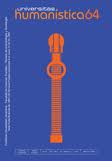Abstract
Beginning with an analysis of the spatial organization of the Usaquén Cemetery in Bogotá, this text proposes that the space of the cemetery functions like a scenario in which the hierarchical order of society is represented and reinforced. This order, however, is not admitted and interiorized totally by cemetery users. Through practices like the Cult to the Holy Souls the hierarchical social order is denied, in a cycle that repeats itself every week when this ritual is carried out. With the exploration of this case study it is proposed that investigations concerning social practices related to death are very useful for understanding the societies that produce them.
This journal provides immediate open access to its content on the principle that making research freely available to the public, encourages greater global exchange of knowledge.
The journal Universitas Humanística is registered under a Creative Commons Attribution 4.0 International Public License. Thus, this work may be reproduced, distributed, and publicly shared in digital format, as long as the names of the authors and Pontificia Universidad Javeriana are acknowledged. Others are allowed to quote, adapt, transform, auto-archive, republish, and create based on this material, for any purpose (even commercial ones), provided the authorship is duly acknowledged, a link to the original work is provided, and it is specified if changes have been made. Pontificia Universidad Javeriana does not hold the rights of published works and the authors are solely responsible for the contents of their works; they keep the moral, intellectual, privacy, and publicity rights.
Approving the intervention of the work (review, copy-editing, translation, layout) and the following outreach, are granted through an use license and not through an assignment of rights. This means the journal and Pontificia Universidad Javeriana cannot be held responsible for any ethical malpractice by the authors. As a consequence of the protection granted by the use license, the journal is not required to publish recantations or modify information already published, unless the errata stems from the editorial management process. Publishing contents in this journal does not generate royalties for contributors.


